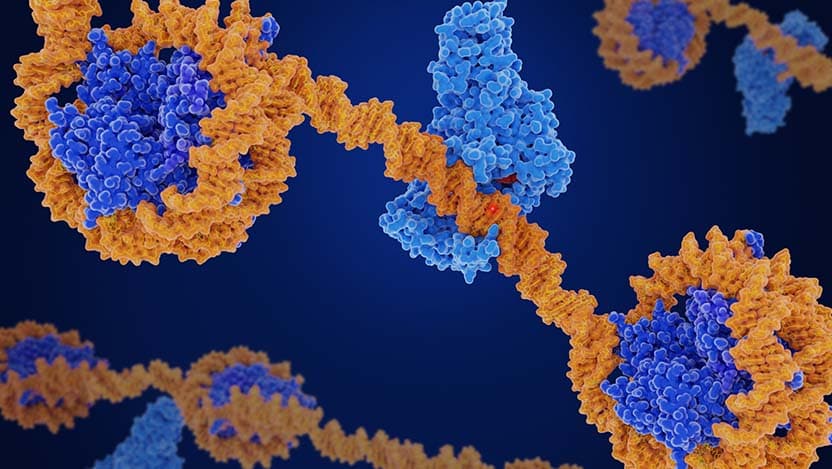UChicago researchers identify a novel function of RNA-binding protein RBFOX2 that drives leukemia

UChicago researchers have identified overexpression of a new epitranscriptomic writer protein, RBFOX2, as a culprit for driving acute myeloid leukemia (AML). The findings were published in Nature Cell Biology on August 28, 2023.
RNA modification: reading, writing and erasing
In healthy individuals, a large number of immature blood cells—also called bone marrow stem cells—proliferate and differentiate, or mature, into normal white blood cells. However, in AML, they proliferate uncontrollably and fail to differentiate into mature blood cells.
Scientists have spent years investigating factors that could explain why this is happening and potentially identify new targets for treatment. Recent attention has turned toward epigenetics—changes in gene expression that are not directed by mutations in the DNA sequence itself. The most common epigenetic modification is methylation, which involves the attachment of small chemical structures called methyl groups to either DNA or RNA.
Adding or removing a methyl group to RNA is like writing or erasing a tag onto RNA that dictates the outcomes of gene expression through "reader" molecules that interact with the tagged RNA. For example, methylation of RNA in bone marrow stem cells keeps the cells in a proliferative state, whereas removal of methyl groups pushes them toward maturing into a different type of blood cell.
m6A methylation in chromatin regulation
One of the important aspects of RNA modification is the addition of a methyl group using a type of protein known as methyl transferases to adenosine at N6 position to form N6-methyladenosine (m6A).
Research from the laboratory of UChicago investigator 2022 showed that methylation can also happen on non-coding RNAs in chromatin, which consists of genetic material packed into a condensed form around histone proteins.
Chromatin modification can regulate gene transcription at a global level, affecting hundreds of genes at once. In his previous research, He characterized a methyltransferase complex of METTL3 and METTL14 (MTC) that together aids methylation of m6A on RNAs. This methylation process can be reversed through FTO (an eraser) or recognized by YTHDC1 (a reader) to control early development. Thus, m6A on chromatin RNA serves as a marker to recruit modifiers or decay machinery to change local or global chromatin states.
Scientists now know that m6A helps regulate carRNA, which affects chromatin states in mammals and plants. However, it is not well understood how the RNA methyl transferase complex (MTC), which writes the m6A tag, arrives at and selects the correct location. Furthermore, scientists are still working to identify specific chromatin factors that preferentially recognize m6A-modified RNAs and interface with the recruitment of MTC and downstream modifiers.
RBFOX2 in chromatin regulation

“Now we ask the question of what are the additional reader proteins other than YTHDC1 that read/ recognize m6A-tagged carRNA and how the methyl transferase complex is brought to the desired sites on the chromatin to achieve site-specific regulation,” said He. “In the current study, we identified a protein called RNA-binding FOX1 homologue 2 (RBFOX2), a previously known splicing factor, but in this case it preferentially binds to carRNA with m6A and recruits other proteins to regulate the chromatin state."
RBFOX2 is a well-known splicing factor that cuts and attaches the functional parts of RNA; however, its new function is not associated with splicing. Although the majority of RBFOX2 binds to splicing sites, a significant percentage binds to promoter RNA.
RBFOX2’s close association with the RBM15 protein allows it to recruit m6A reader YTHDC1 and another protein, Polycomb repressive complex 2 (PRC2). YTHDC1 binding to PRC2 resulted in chromatin regulation via transcriptional inactivation.
“These findings highlight the role of RBFOX2 in the regulation of chromatin at m6A-modified carRNA sites through an RBM15–YTHDC1–PRC2 pathways,” said He.
Studying how RBFOX2 functions in leukemia
To understand how RBFOX2 modifies cell function, He and colleagues grew malignant hematopoietic stem cells with RBFOX2 deactivated in petri dishes and found that the proliferative capacity of the cells was markedly reduced, indicating that there might be higher expression of RBFOX2 in leukemia cells.
“As we predicted, our collaborators’ investigation from a large cohort of severe acute myeloid leukemia (AML) patient samples revealed an overexpression of RBFOX2, which is highly correlated with poor prognosis,” said He.
Hematopoietic stem cells should undergo differentiation, but because of the high RBFOX2 expression, they are stuck in a proliferative state, which He pointed out as problematic.
He also emphasized that, to his knowledge, this is the first report showing the upregulation of RBFOX2 in severe AML patient samples. The researchers hypothesized that this could serve as a diagnostic and prognostic marker.
This study provides a direction to develop novel therapies that target RBFOX2 for leukemia patients and encourages the identification of novel epigenetic markers that can be used to better understand various types of cancers.
Pioneer in epitranscriptomics
The He lab has been studying epigenetics for more than a decade to understand the physiological significance of RNA modifications at various cellular developmental events, such as proliferation and differentiation.
His studies helped to usher in “epitranscriptomics,” an exciting new field in biology that studies the epitranscriptome, referring to the collective set of modified, or tagged, RNA.
Earlier in 2023, he was awarded the prestigious Wolf Prize in Chemistry for his pioneering discovery of reversible RNA methylation and its role in gene expression. More recently, he was awarded the 2023 Tetrahedron Prize for Creativity in Bioorganic and Medicinal Chemistry and selected for winning the 2023 Falling Walls Science Breakthrough of the Year for life science.
“RBFOX2 recognizes N6-methyladenosine to suppress transcription and block myeloid leukaemia differentiation” was supported by grants from the National Institutes of Health, the National Science Foundation and the Simms/Mann Family Foundation.
Additional authors include: Xiaoyang Dou, Yu Xiao, Tong Wu, Chang Liu, Qing Dai, Kinga Pajdzik, Chang Ye, Ruiqi Ge, Boyang Gao, Xianbin Yu, Jun Liu and Mengjie Chen from the University of Chicago; Chao Shen, Kitty Wang, Jianjun Chen, and Jianhua Yu from City of Hope, Duarte, CA; Yini Li and Shuying Sun from Johns Hopkins University School of Medicine, Baltimore, MD.

UChicago Medicine Comprehensive Cancer Center
UChicago Medicine is designated as a Comprehensive Cancer Center by the National Cancer Institute, the most prestigious recognition possible for a cancer institution. We have more than 200 physicians and scientists dedicated to defeating cancer.
Learn More About the Comprehensive Cancer Center